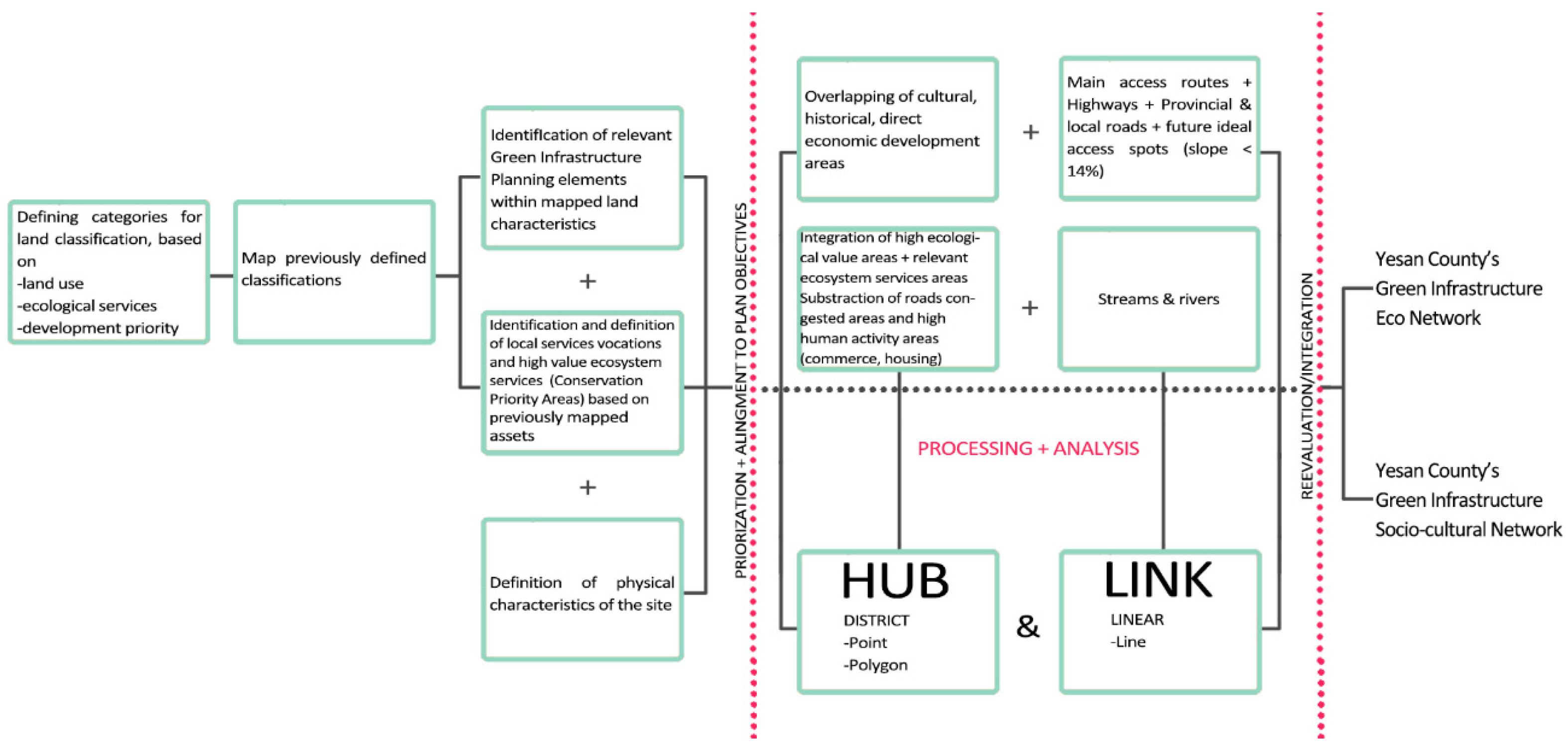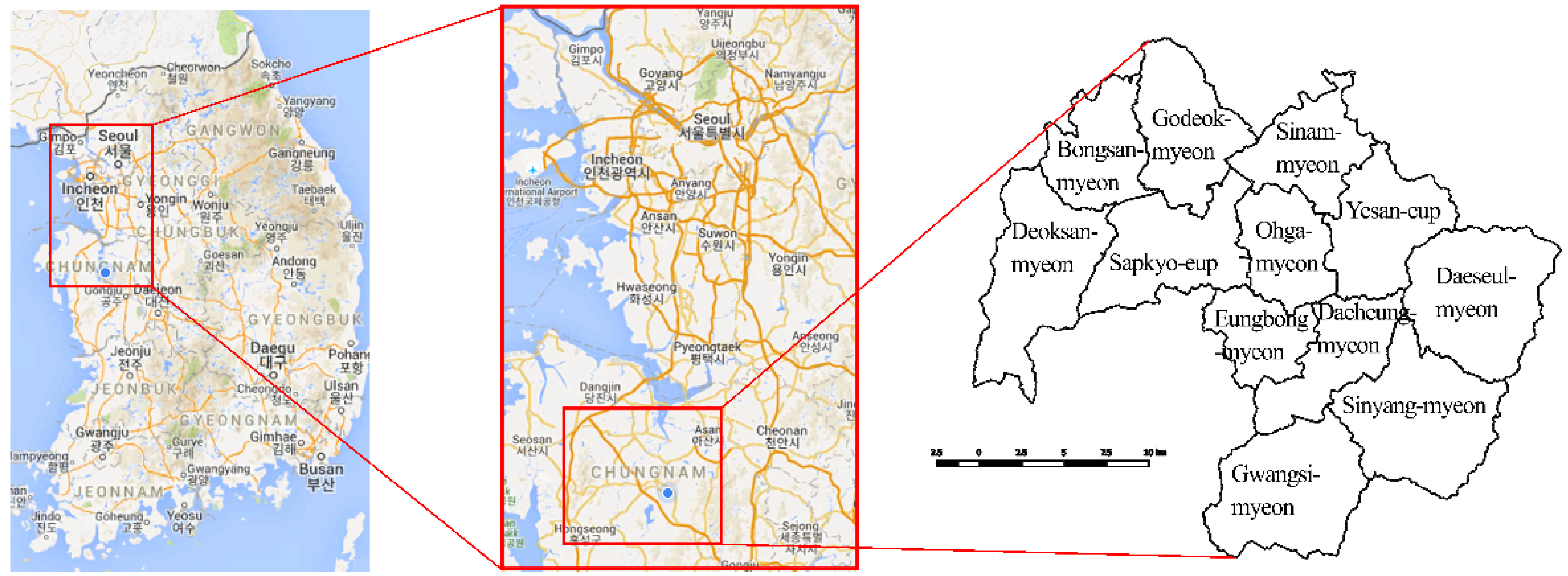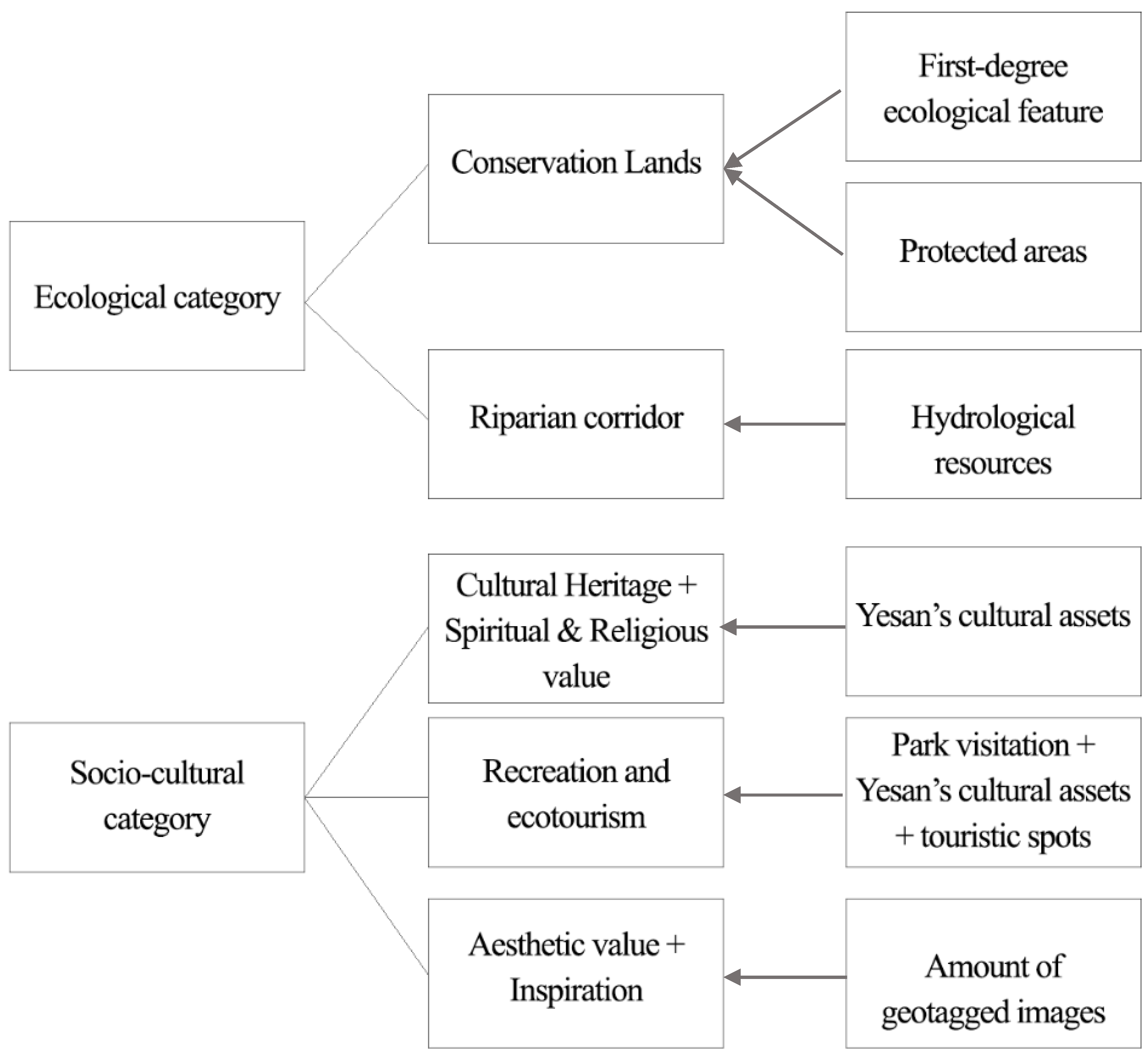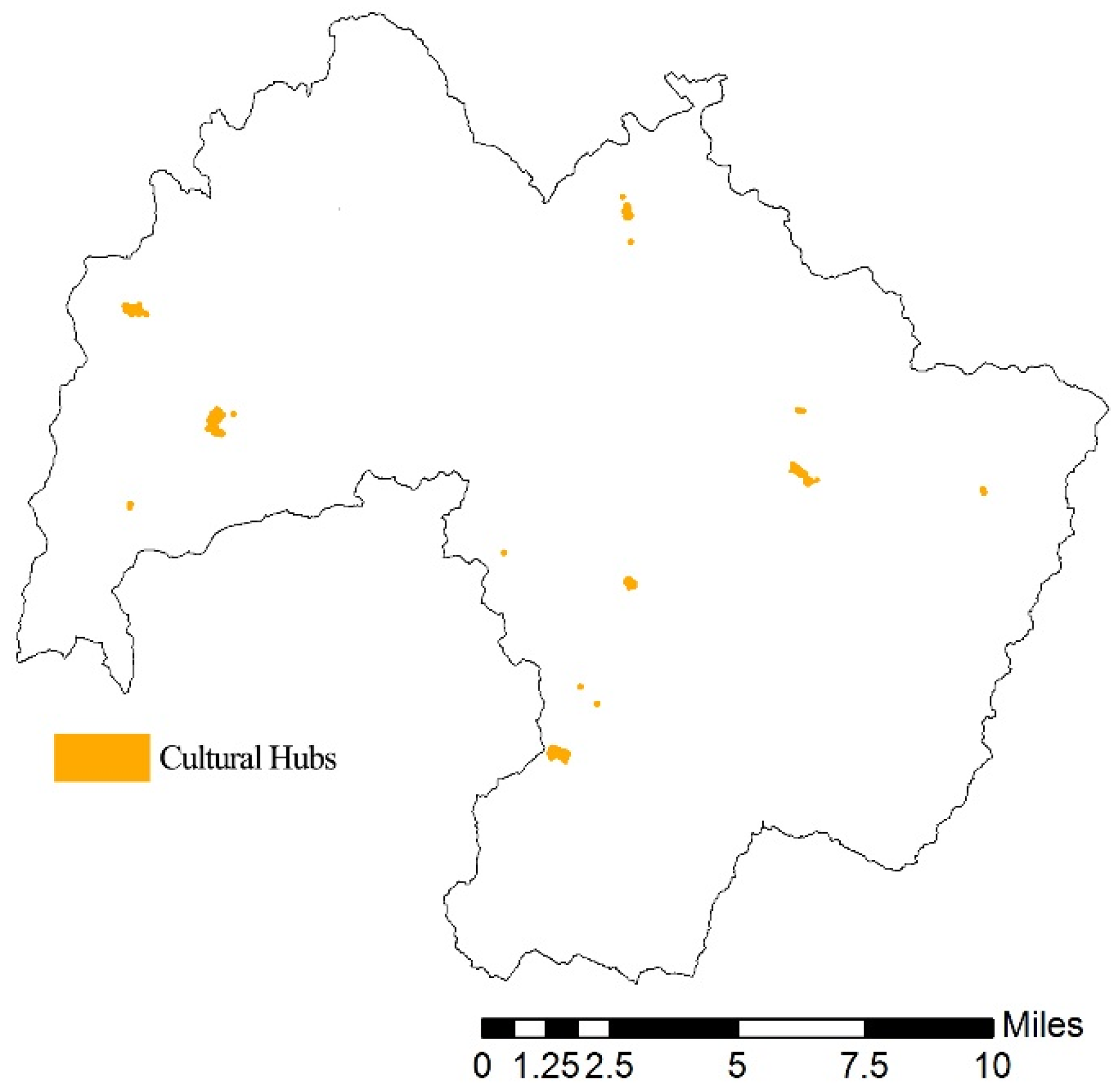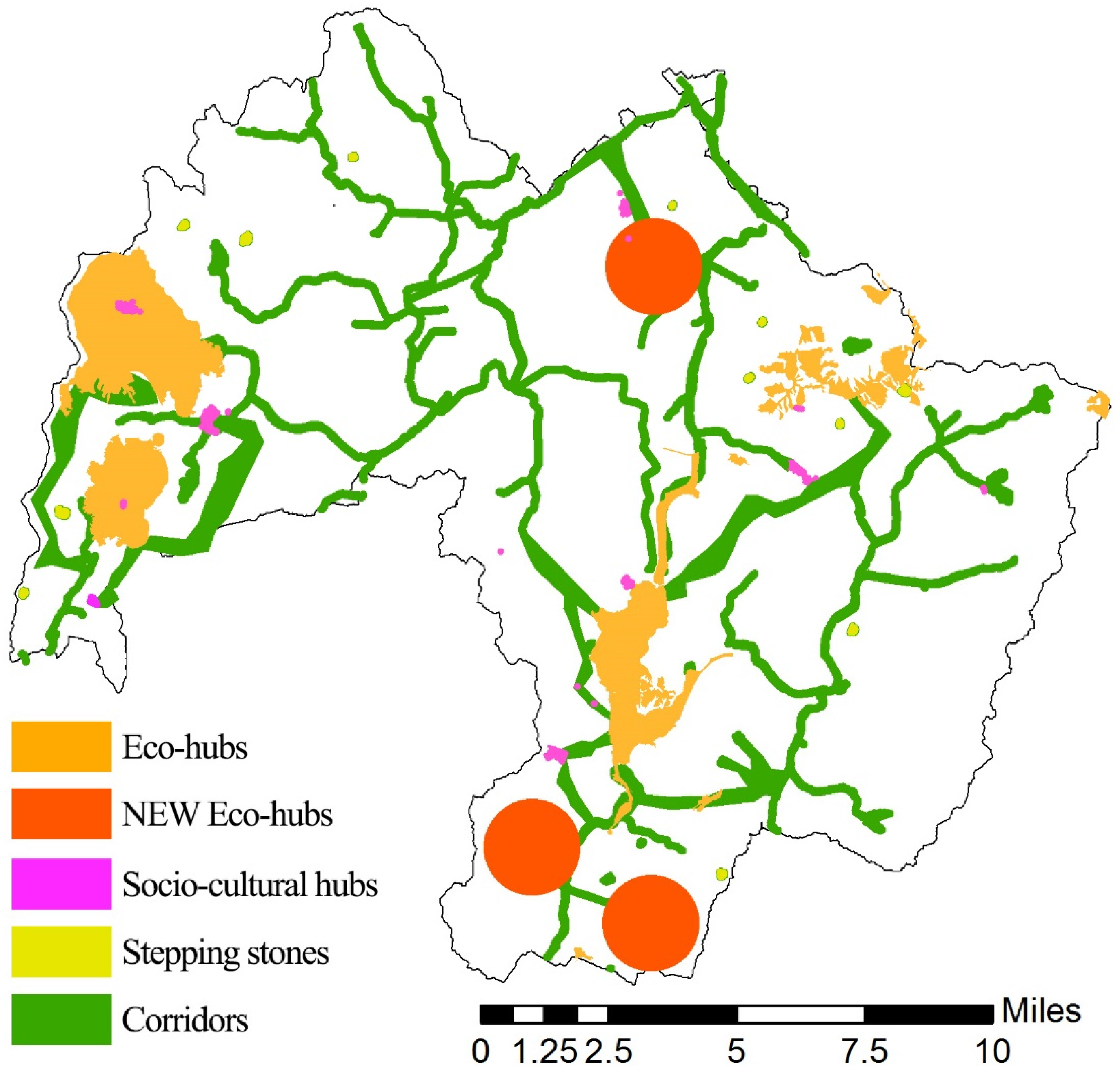2.2. Methodology
A literature review of Ecosystem Services was conducted in order to identify the characteristics of the amenities involved in the provision of benefits that come from nature. The patch-corridor-matrix model [
18] was employed for the definition of the system.
Based on Yesan’s special characteristics, two main categories were selected as the focus of the investigation: “Ecology” and “Society and Culture”. Considering
Table 1, the “Physical” category was not explicitly taken as one of the categories to incorporate in the research, as the challenges previously mentioned for “Physical” (public transportation and taxi problems) were assimilated and could be treated indirectly by focusing on the Socio-cultural and Environmental categories, providing a background tool for the definition of more ecologically friendly and efficient transportation routes.
As for the opportunities mentioned, they are mainly connected to Yesan’s location in relation to Seoul and its metropolitan area. This is linked with the importance and influence the project will exert by being located at the heart of Chungnam area, connecting Seoul, its metropolitan area, Daejeon (Fifth biggest city in Korea and the center of its transportation routes), Sejong (Korea’s administrative capital) and the South-west area of the Korean peninsula. Taking this consideration, the analysis and definition of the system was summed to two main categories only.
Summarily, the Ecology category is comprised of two sub-categories: (1) Conservation Lands; and (2) Riparian Corridors. The Conservation Lands are composed of the First-Degree Ecological Features and the Protected Areas maps. As for the Riparian Corridors, they are composed of the Hydrological Resources map.
For the Socio-cultural category, the resulting three subcategories are: (1) Recreation and Ecotourism; (2) Aesthetic value + Inspiration; and (3) Cultural Heritage + Spiritual and Religious value. Recreation and Ecotourism was defined based on the indicators of Park Visitation, Cultural Assets, and Touristic Spots mapping. The Aesthetic value + Inspiration category is based on the indicator of the Amount of geotagged images. As for the Cultural Heritage + Spiritual and Religious value, Yesan’s cultural value assets were the base (
Figure 3).
The Ecology category of this GI plan encompasses high ecological value natural resources and areas in Yesan, and the Ecological Ecosystem Services that they provide. The categorization of the areas was based on pre-existing land classification, a rank of ecological features defined by the National Land Planning and Utilization Act of the Republic of Korea. This criterion was selected as the method of mapping classification for the ecological character of the land, since the National Land Planning and Utilization Act is established around land characteristics. As such, Yesan is a part of the subject of the law, matching the background and special characteristics of it. The categories considered for the mapping of the ecological categories of the Yesan GI Plan were the First-Degree Ecological Features, Conservation Priority areas, Forestry and Agriculture, and Hydrological Resources. To these four categories, ad-hoc data on roadkill were added in order to analyze areas where further ecological intervention should be proposed for protection of the native fauna. As a final step, a slope categorization through Digital Elevation Model (DEM) was created through GIS processing tools, along with a set of base maps for the spatial analysis of Yesan’s territorial characteristics (
Figure 4).
For the classification of both the Ecology and Social and Cultural categories, a scale from 1 (lowest value) to 3 (highest value) was used for the pre-weighting of the layers in GIS software. In the case of the Social and Cultural category, this pre-weighting was performed specifically for the main categories defined through a diverse set of indicators. In order to give priority to nature preservation, a weight of 3 was applied to the layers of physiological characteristics of the terrain, giving it the highest value in comparison to the socio-cultural layers to be used.
For the following analysis process, first, the ecological hubs were chosen under the base of the First-Degree Ecological Features and Protected Areas (
Figure 5a). Second, following the patch-corridor model, the corridors were defined using an overlaying method with GIS application software. This was done while avoiding areas with a lot of human activity influence, such as expressways, secondary roads, and heavily urbanized areas for the ecological network, and areas with rugged terrain that complicated the access for the socio-cultural network. The Forestry and Agriculture layer was introduced as a vector layer, weighted with a qualification of 3 points, rasterized, and then reclassified into an overall value of 2. Thirdly, the slope was obtained through the DEM raster and classified into five different categories as per a classification defined by Ahn et al. [
22] in their Forest Management book about Korean forestry. The Slope Classification layer was also reclassified into five classes, assigning a value in between 1 and 5 for each category.
As a fourth step, both the Forestry and Agriculture Reclassification layer and the Slope Reclassification layer were overlaid using the Weighted Overlay method. A 50% influence from each layer was chosen, as both of them exert the same influence over the configuration of the land. Then, for the considered values, the first, second, and last levels of the Slope raster were designated as Restricted area values. This was defined according to two different criteria: (1) Levels 1 and 2 are composed of a 10° or less slope, which are the regular areas where existing roads cross the landscape and human activity exerts a big influence on the fragmentation of the land; and (2) a slope above 40°, which belongs to Level 5, represents a challenge of mobility either for humans or for fauna. After the Weighted Overlay method was applied, three different areas were obtained according to the 1–3 weights previously assigned, which resulted in three different orders of corridor importance.
Fifth, the Hydrological Resources and Wetland layers were added to the map with a buffer of 100 m to complete the corridors layer (
Figure 5b). After the Patch and Corridors were defined based on existing conditions, the roadkill data were included, taking into consideration where the concentration of roadkill was higher. This marked an indication of where New Eco Hubs should be added for fauna conservation (
Figure 5c). These New Eco Hubs were defined by the concentration of roadkill points in an area, choosing the central point to the concentration area and defining a double ring buffer around it, with 500 m for the critical areas and 1500 m for its maximum reach [
23,
24].
As for the socio-cultural division of Yesan’s GI Plan, the category includes: (1) the natural resources that provide Cultural Ecosystem Services (CES); and (2) the social and cultural amenities that have the potential to become an integral part of Yesan’s GI by complementing the uses of the ecological value areas and providing similar Cultural Services as those provided by natural resources.
In order to identify indicators for the CES of Yesan’s GI Plan, a comprehensive review of indicators realized by La Rosa et al. in 2015 [
25] was employed. The study included a recent and extensive analysis of CES papers throughout Scopus and ISI Web of Knowledge and provided an important tool for future planning. It also highlighted the fact that, among the analyzed papers, no indicator was designed specifically for urban areas, allowing the use of their analyzed criteria for rural towns and their own particular socio-cultural characteristics.
Out of the final set of indicators, a weight between 1 and 3 was assigned to each category according to the correspondence to the different problems and opportunities in Yesan and the number of indicators linked to the service (
Table 2). This weighting between 1 and 3 was realized in order to maintain the correspondence with the pre-weighting performed over the Ecological category layers classification. However, within each category, a classification between 1 and 4 was executed in order to run more precise results that would encompass and define better the diverse socio-cultural aspects and amenities being analyzed.
After assigning the correspondent values to the weight, five categories were selected among those of the study from La Rosa [
25], as they are the most relevant to Yesan’s case study: Cultural Heritage, Spiritual and Religious value, Recreation and Ecotourism, Aesthetic Value, and Inspiration. However, the Inspiration and Aesthetic Value categories were unified as one, as inspiration is defined by a place or person that makes someone want to do or create something, making it possible to consider aesthetically beautiful places as inspiring sources of contemplation. At the same time, the Spiritual and Religious values category was incorporated into the Cultural Heritage division, by considering spiritual beliefs a part of a person’s cultural expression system (
Table 3).
For each of the different CES categories selected, a different proxy was chosen based on previous studies.
